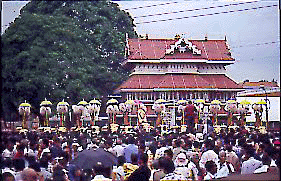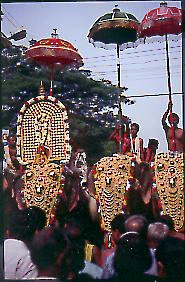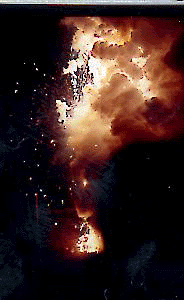 |
|
Home |
Thrissur Pooram is a major event for every person who is living in this town and near by villages. This festival has become so popular that it was declared as the festival of the day at www.festivals.com on the 25th of April, 1999. Pooram is a festival which lasts for 2 days. The town would have become a place of hectic activities much before the festival. Trade Fairs, and the decorative towers are setup. The festival has got many small temples as participants, along with the two major temples of the town Thiruvambady and Paramekkavu who has got the highest privileges and honours. The major events however takes place in and around Vadakkunnathan temple which has lord Shiva as its cheif diety. At around 7 am in the morning, the Ezhunallippu from Thiruvambady begins. At the same time, the processions from each of the surrounding temples too reach the town through a different route. All these processions finally reach in front of Vadakunnathan temple and would enter it. Each of these processions are led by musicians playing the traditional Chenda Melam (Drum Music).
It would have been noon, and the hot sun would be blazing, but it would be time for Elanjithara Melam (Drum music in front of the Elanji tree). More than a 100 artistes take part in this orchestra playing the traditional Keralite music Melam which uses both percussion and wind instruments. This program starts after the procession from Paramekkavu temple enters Vadakkunnathan temple through the eastern gate. After this it is time for the Kuda mattam(changing of the parasols). Here 10 elephants from both the processions stand face to face, and there is a changing of the umbrellas which are held on top of elephants. This ritual is the widely watched item, and the people standing in-between the two sets of elephants just cheer on both the parties. Late in the evening, this function comes to a close, and the crowd just disperses.
The next day morning there is a small ritual of Pakal Pooram (Day-time rituals) and this goes all the way upto the afternoon. In the afternoon, the elephants bearing the figures of the dieties, will salute each other (using the trunks), and they return to their respective temples. They will then have a re-union, the following year in the auspicious day of Pooram, which comes in the month of April-May. This time Pooram for me was a major event since I had a friend who had come all away from Hamburg, Germany to witness this festival. Herr Siegfried Lindemann, was there taking photographs, and listening to the music. The photographs in this page are from his collection. This pooram was an unforgetable experience for me thanks to my friends Sreekumar and Herr Lindemman. |

 In the mean time the elephant from
the Thiruvambady procession bearing the diety (see the picture to the left) would
have gone to the Madham (Monastery) to get some of the ornaments worn by the
elephant. The reason for doing so was a century old practise. Many years ago, the
procession of Thiruvambady required some of the elephant's ornaments which was kept in the
safe custody of the head priest of the monastery. When the authorities contacted the head
priest, he told them that he will not give the ornaments to the temple, instead the
procession can come upto his monastery, wear all the decorations from there, and then
proceed towards Vadakkunnathan temple. This practise later came to be known as Madathile
Varavu (the march from the monastery).
In the mean time the elephant from
the Thiruvambady procession bearing the diety (see the picture to the left) would
have gone to the Madham (Monastery) to get some of the ornaments worn by the
elephant. The reason for doing so was a century old practise. Many years ago, the
procession of Thiruvambady required some of the elephant's ornaments which was kept in the
safe custody of the head priest of the monastery. When the authorities contacted the head
priest, he told them that he will not give the ornaments to the temple, instead the
procession can come upto his monastery, wear all the decorations from there, and then
proceed towards Vadakkunnathan temple. This practise later came to be known as Madathile
Varavu (the march from the monastery).  Night would fall, and all the temporary
towers raised would be illuminated. By around mid-night people will start crowding for the
major event of the festival - the Vedikkettu (Fire works display). The wait for the
fire works to start is a long one, and may be at 2 a.m, either Paramekkavu or Thiruvambady
lights the first cracker. After the first cracker is lighted the whole atmosphere changes.
Unlike in most other fire displays, here each and every cracker is not lighted. The
crackers are placed in small pits in the ground, and a route is made between them using
gun powder. Once the fire is lit, it goes to each and every pit throwing up the cracker
placed inside it. The cracker goes up and bursts. With each cracker bursting, the sound
increases. And finally it reaches the 'Finishing Point' where a huge ball of light is made
up (see the picture on the right) and the sound becomes so deafening, that most of the
people unknowningly takes steps backwards!
Night would fall, and all the temporary
towers raised would be illuminated. By around mid-night people will start crowding for the
major event of the festival - the Vedikkettu (Fire works display). The wait for the
fire works to start is a long one, and may be at 2 a.m, either Paramekkavu or Thiruvambady
lights the first cracker. After the first cracker is lighted the whole atmosphere changes.
Unlike in most other fire displays, here each and every cracker is not lighted. The
crackers are placed in small pits in the ground, and a route is made between them using
gun powder. Once the fire is lit, it goes to each and every pit throwing up the cracker
placed inside it. The cracker goes up and bursts. With each cracker bursting, the sound
increases. And finally it reaches the 'Finishing Point' where a huge ball of light is made
up (see the picture on the right) and the sound becomes so deafening, that most of the
people unknowningly takes steps backwards!  The same event is repeated by the next
party. Then both the parties turn to the colour fire works display. The crackers go up and
burst creating a wide range of colours (see picture on the left). The fire crackers which
go up and burst some times has got smaller crackers which even goes further up and
explodes, thus forming some thing like a multi-level fire cracker! Around 50 to 75 years
back this used to be in the range of over 25 levels, but now it has been reduced to a
lesser level by the police authorities. At dawn the fire work display ends, and the major
part of the pooram is finished.
The same event is repeated by the next
party. Then both the parties turn to the colour fire works display. The crackers go up and
burst creating a wide range of colours (see picture on the left). The fire crackers which
go up and burst some times has got smaller crackers which even goes further up and
explodes, thus forming some thing like a multi-level fire cracker! Around 50 to 75 years
back this used to be in the range of over 25 levels, but now it has been reduced to a
lesser level by the police authorities. At dawn the fire work display ends, and the major
part of the pooram is finished.